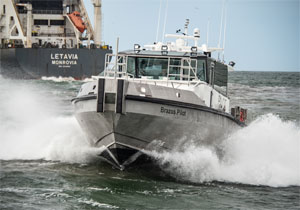On two ride-alongs aboard Brazos Pilot, rough sea conditions did not hinder the new pilot boat from making the sea buoy at the entrance to the harbor at Freeport, Texas.
The first trip, in 6- to 8-foot seas on a frosty January day, was to deliver a pilot, Capt. Matthew Krohn, to the containership Bomar Resolute. The second ride, in 5- to 6-foot seas on a warm but windy day in late April, was to board Capt. Ross Coviello on the containership Letavia.
The 64-by-19-foot Brazos Pilot was designed and built to operate in such conditions.
“The boat’s seaworthiness is a big improvement,” said Jack Stanley of the Brazos Pilots Association, the boat’s operator on the January ride. “It’s a bigger, heavier boat than the previous one and has more freeboard, and the visibility is tremendous.”
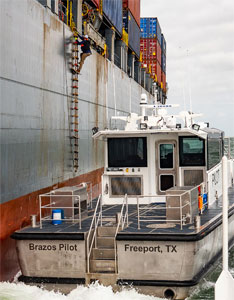 |
|
The boat stays firmly on station as Capt. Ross Coviello climbs the pilot ladder to the main cargo deck of Letavia. |
Stanley added that in the past they would operate in similar conditions with the 36-year-old Freeport Pilot, but the trip would take much longer and be much rougher.
Capt. Billy Burns, president of the pilots association, explained the motivation for acquiring the new Defiant-class vessel, designed and built by Metal Shark Boats at its Franklin, La., shipyard.
“We started with the question, how do we bring oil, car carriers, containers, whatever, into Texas waters safely for the cargo, the mariners and the environment?” he said. “That’s job safety. Then there is the personal safety of the boat operators and pilots.”
Transferring a pilot with the 45-foot, single-screw Freeport Pilot, with less than 400 hp, was accomplished at 6 knots. The 1,606-hp Brazos Pilot performs the operation at 10 knots.
The new boat is 19 feet longer, 6 feet wider and three times heavier than Freeport Pilot, resulting in improved stability and seaworthiness.
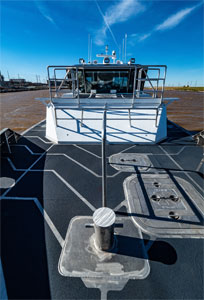 |
|
The launch’s boarding platform is raised three feet from the foredeck to keep the pilots out of spray in heavy weather. |
The increase in speed adds a degree of safety when transferring pilots on and off the larger, faster ships, and a higher gunwale takes on bigger seas. For more safety and comfort, the boarding platform is raised off the foredeck by three feet to get the pilot up out of the spray during transfers.
Burns explained that the platform was fitted at the pivot point of the boat just ahead of the pilothouse, the closest and safest transfer point against a ship’s hull.
Brazos Pilot, powered by twin 803-hp C18 Caterpillar mains, Twin Disc gears and five-blade Michigan Wheel propellers, makes 28 knots, but the boat was designed for power, not speed.
“Although nice to have, our real design criterion was the ability of the boat to break powerful suctions that large ships generate near their stern,” Burns said. “These suctions are very dangerous to pilot boats, and many pilot boats have been sunk because they lacked the power to break away from the ship.”
He also said the boat was designed with features to allow it to operate in heavier seas. The gunwales are raised, the bow flare is deeper and the freeboard is taller than on its predecessor.
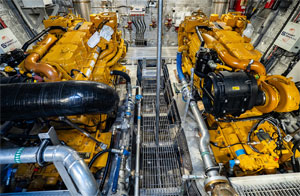 |
|
A pair of Caterpillar C18 diesels give Brazos Pilot a top speed of 28 knots and the power to break stern suction when maneuvering alongside ships. |
“The 64 Defiant Pilot employs a very stout, extensively proven deep-V hull for stable operation in heavy seas,” said Carl Wegener, vice president of commercial sales for Metal Shark. “The entire vessel has been thoroughly optimized for pilots, with an emphasis on comfort, convenience, efficiency and safety.”
“She has the capability of a big boat to shoulder through the sea,” said Brazos Pilot operator William Lowery on the April run.
“She cuts through the waves and holds her designed speed in 5- to 7-foot seas,” Krohn said. “She’s able to take the seas a lot better than the older boat because she is heavier and has a 3-foot-higher deck. She’s also a lot drier and quieter. The acoustics deaden the outside sounds, making it easier to communicate in the cabin.”
Five Llebroc Bandera shock-mitigating seats, which soften the blows in heavy seas, each have a footrest, cupholder, gooseneck light and 110-volt USB plug for passenger comfort and convenience. There is also a settee and table at the rear of the cabin.
The bridge console consists of a suite of Furuno navigation electronics. The GPS, radar, depth sounder and AIS are accessed primarily through three 19-inch Furuno multifunction displays. The large touch-screen panels also display real-time video from a FLIR thermal imaging camera, as well as live onboard video feeds from two CCTV cameras installed in the engine room.
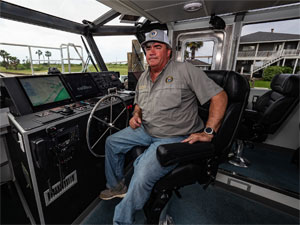 |
|
The newbuild’s attributes quickly became apparent to its operators. “She has the capability of a big boat to shoulder through the sea,” says Capt. William Lowery, shown in the boat’s spacious wheelhouse. |
The gyrostabilized FLIR camera is a great aid and safety feature for the pilots at night. “Night operations have always been more dangerous,” Burns said. “If a pilot were lost in the water, the boat could only use spotlights to find him. Now, using the FLIR camera, you can spot a man in the water at night from two miles away.”
The large wheelhouse has 360-degree visibility as well as skylights for a direct line of sight to the pilot ladder. Metal Shark installed its signature “pillarless glass” and reverse-raked windows to minimize glare and improve visibility.
The accommodations include a galley and berth area with two bunk beds, drawer storage, and an LED television with Blu-ray player and KVH satellite TV system. The finishes and aesthetics of the interior are intended to create a bright, airy and comfortable atmosphere for crews on board for extended periods.
Outside, Brazos Pilot has fully flush non-skid decks, a non-skid boarding platform, and handrails placed for easy reach at all times. There is also a low-level LED light pathway for safety during nighttime operations.
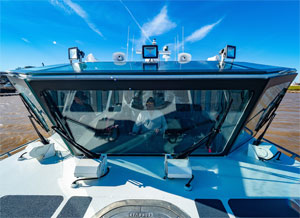 |
|
Metal Shark’s “pillarless glass,” reverse-raked windows and skylights provide 360-degree visibility and a direct line of sight to the pilot ladder. |
On the aft deck, the boat is outfitted with a secondary control station, complete with steering and throttle controls and a set of digital displays, for close-quarters operations.
“Our port and the maritime industry have changed, grown and evolved over the past four decades in ways we could not have imagined then,” Burns said. In lockstep, mission requirements for pilot boats have evolved, too.
Currently the Freeport Channel is being deepened and extended from three to five miles out to accommodate larger ships. The expectation is for the channel to reach from eight to 10 miles offshore in the next eight years.
“Freeport Pilot was never designed to do what we require out of a pilot boat today,” Burns said. “To compare the two boats is like comparing a 1920 Ford Model T with a 2019 Ford F-250.”
“Transferring personnel on and off huge ships at sea is a dangerous job,” he added. “It’s important for pilot associations to have the safest equipment possible. The pilot boat is the platform on which all other safety systems are built.”

